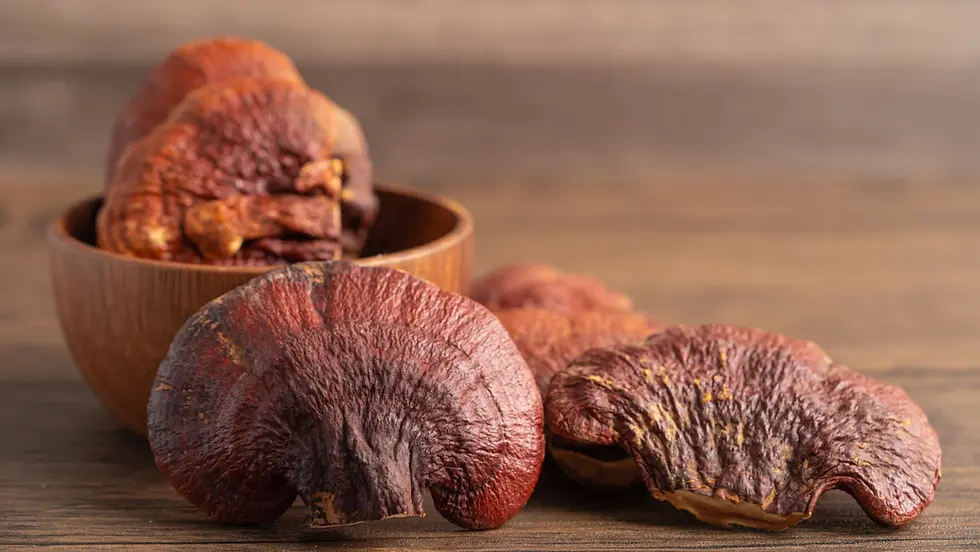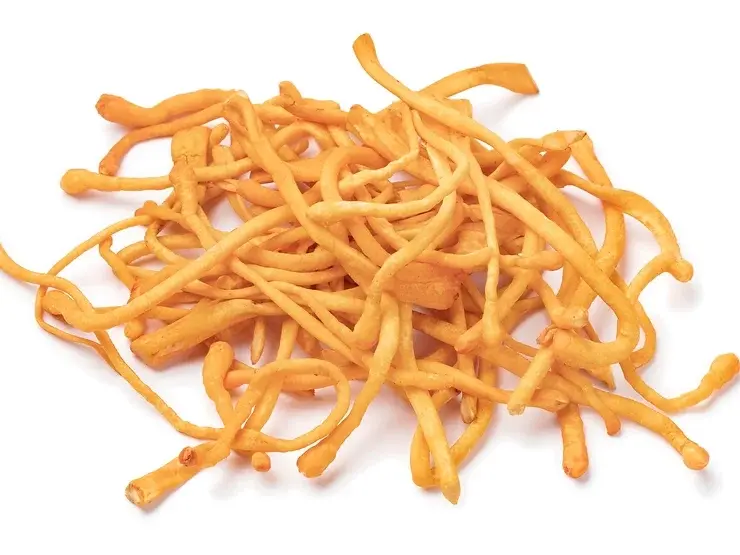How are adaptogenic mushroom extracts made?
- Małgorzata Łopata

- May 5
- 4 min read
How Adaptogenic Mushroom Extracts Are Made
Choosing the right adaptogenic mushrooms:
The whole process begins with carefully selecting the right adaptogenic mushrooms, such as Lion's Mane (Hericium erinaceus), Reishi (Ganoderma lucidum), Cordyceps (Cordyceps sinensis), Shiitake (Lentinula edodes), and Maitake (Grifola frondosa). Each of these mushrooms has its own unique bioactive compounds that positively impact health and well-being.

Dried Reishi Mushrooms
How to grow mushrooms under controlled conditions:
After selecting the right species, scientists begin cultivating the mushrooms in special laboratory conditions. They can use different substrates, such as wood, grains, or plant extracts. They make sure that climatic conditions, such as temperature, humidity, and light, are carefully controlled so that the adaptogenic mushrooms can grow and develop as best as possible.

Cordyceps dried mushroom
Extraction of bioactive compounds:
Once the adaptogenic mushrooms have reached the appropriate stage of maturity, the bioactive compounds are extracted. There are many extraction methods, such as water extraction, alcohol extraction, ether extraction, and two-phase extraction. The selection of the appropriate extraction method depends on the chemical properties and structure of the compounds to be extracted.

Chaga dried mushroom
Water extraction
Water extraction is a process that usually uses hot water or distilled water. It can be done in various ways, such as traditional boiling, using special extraction devices or pressurized reactors. During this process, water is in contact with the raw material for some time, usually from several hours to several days.
Extraction parameter control:
During water extraction, it is important to control various parameters, such as temperature, extraction time and water-to-raw material ratio. Extraction temperature is usually between 60 and 100 degrees Celsius, but can vary depending on the mushroom species and the intended effect. Extraction time also plays a role and can be adjusted to the specific extraction procedure.
The water to raw material ratio determines how much water is used in relation to the amount of raw material, which affects the concentration of the final extract. Once extraction is complete, the resulting extract solution is centrifuged to separate the solid mushroom residue from the liquid extract. The solution is then filtered to remove any insoluble particles and impurities.
Adaptogenic Mushroom Extraction
Drying can be done in several different ways:
Freezing: The freezing method involves exposing the extract to a low temperature, which causes the water state of the extract to change into ice. The ice is then subjected to a sublimation process, as a result of which the water in the form of ice passes directly into a gaseous state, leaving a dried extract. This method is particularly useful for preserving the full activity of bioactive ingredients.
Freeze-drying: Freeze-drying, also known as sublimation drying, is a process in which freezing and evaporation of water are combined. The extract is frozen and then placed in a freeze-drying chamber, where, under the influence of low pressure and heating, the frozen water sublimates. This process leads to a dry and porous product with a longer shelf life.
Extract concentration:
In order to obtain a more concentrated extract, it can be subjected to a concentration process. The most commonly used method is to evaporate water to reduce the volume of the extract solution.

Liquid extract
Alcohol extraction:
Alcohol extraction is a way to extract bioactive compounds from mushrooms using alcohol, such as ethanol or methanol. This method is popular because alcohol is great at extracting various active substances. Adaptogenic mushrooms are soaked in alcohol for a while, then filtered and evaporated to obtain a more concentrated extract.
Essential oil extraction:
Ethereal extraction involves extracting bioactive compounds using organic solvents such as ethers or volatile solvents. This method is great for extracting volatile compounds that are hard to capture in other ways. This can be done using various techniques such as distillation, hot extraction, or ultrasound.
Two-phase extraction:
Two-phase extraction, also known as liquid-liquid extraction, uses two insoluble liquids to extract bioactive compounds from mushrooms. Typically, one of the liquids is water and the other is an organic solvent such as ethanol or hexane. The adaptogenic mushrooms are extracted by contact with both liquids, and then the solution is separated, filtered, and evaporated.

Drying the extract:
After getting rid of the excess alcohol, the extract is dried to a permanent form, usually as a powder. Spray drying is used in this process. This involves the liquid extract being placed in a special chamber where it is sprayed into small droplets. These droplets are then heated to a high temperature at the entrance (170℃) and a lower temperature at the exit (70℃), which quickly evaporates the solvent (alcohol) and leaves a dry powder extract.
Dry extract
At the end of the process, the extract is dried to a stable form, such as a powder or liquid. Additionally, to maintain quality and consistency, adaptogenic mushroom extracts often undergo standardization.
Evaluation and standardization of extracts:
After extraction, extracts are assessed for quality and active ingredient content. Standardization involves determining quality parameters, such as the content of specific chemical compounds or biological activities.
Methods such as high-performance liquid chromatography (HPLC) and mass spectrometry are often used to analyze extract components. Standardization helps maintain uniform quality and efficacy of adaptogenic mushroom extracts, which is important for their use in dietary supplements and medicines.

Neurigo is an Orvicta product created based on a mixture of extracts
Here are some sources that can provide more information on the process of creating adaptogenic mushroom extracts:
Bisen, P. S., Baghel, R. K., & Sanodiya, B. S. (2010). Medicinal mushrooms: a new source of therapeutic compounds for the future. Biotechnology Letters, 32(3), 483-495.
Chamyuang, S., & Phupong, W. (2017). Chemical composition and biological activities of extracts from medicinal mushrooms: A review. Pharmaceutical Biology, 55(1), 758-767.
Khan, M. A., Tania, M., Liu, R., & Rahman, M. M. (2013). Hericium erinaceus: An edible mushroom with medicinal values. Journal of Complementary and Integrative Medicine, 10(1), 253-258.
Panossian, A., & Wikman, G. (2010). Effects of adaptogens on the central nervous system and the molecular mechanisms associated with their stress-protective activity. Pharmaceuticals, 3(1), 188-224.
Patel, S. (2017). Cordyceps—A gift of Himalayan medicine to the world. International Journal of Pharmacy and Pharmaceutical Sciences, 9(10), 1-6.
Paterson, R. R. (2018). Cordyceps: A traditional Chinese medicine and another fungal therapeutic biofactory? Phytochemistry Reviews, 17(2), 303-316.
Wachtel-Galor, S., Yuen, J., Buswell, J. A., & Benzie, I. F. (2011). Ganoderma Lucidum (Lingzhi or Reishi): A Medicinal Mushroom. In Herbal Medicine: Biomolecular and Clinical Aspects (2nd ed.).
Wang, D., & Li, S. (2018). Extraction of bioactive compounds from Ganoderma lucidum and their health benefits. Food Science and Human Wellness, 7(3), 173-183





Comments